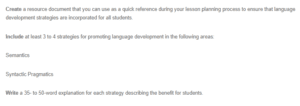Language Development Strategies
Speech, communication, and language are critical areas of child development. They play an important part in our lives and influence several other aspects of development like cognitive development, social development, and literacy development. There are three main components of language development, namely semantics, syntactic, and pragmatics.
Semantics
This refers to the meanings of words. To develop semantic skills, various strategies are applicable, which include:
Elaboration of new terms
First, it is important to label as well as elaborate on new terms, while reading with children. This strategy allows the adult to make comments, which draws the learners’ attention towards these words. It can also lead to question-and-answer sessions.
Synonym identification game
Secondly, the adult can initiate a synonym identification game, which promotes learning of the words’ meanings. The learner can point out words that they cannot identify as synonyms. This marks the beginning of learning new words and their meanings.
Prepositional game
Thirdly, the adult and learner could take part in a prepositional Simon says game. This strategy allows the learner to conceptualize the prepositions and capture their meanings. It promotes the process of learning the various prepositions that arise from the game (Sedita, 2020).
Syntactic
This refers to the arrangement of words in a sentence. To develop syntactic skills, various strategies are applicable, which include:
Sentence scramble
Sentence scramble can be used to develop syntactic awareness. During the activity, students can arrange words to make sentences. These words may be in placards or written down. They can understand the proper position of words, phrases, as well as clauses.
Sentence elaboration
Sentence elaboration can also be used to develop syntactic awareness. Beginning with a single word, it is possible for students to expand on this through question words. Each elaboration provides a deeper understanding of the words that are chosen.
Verb exercises
Verb exercises can also be used, where children construct sentences using the verbs. This should create an understanding of each verb’s position and tenses in the sentence. The learners will encounter new verbs, whose meanings they learn as well as application (Hanson, n.d).
Pragmatics
This refers to the use of language. To develop pragmatic skills, various strategies are applicable, which include:
Role play
Role play can be used and conducted in different settings. It facilitates the learners’ ability to use language to explain different aspects. The varied contexts in the role-play environment promote critical thinking about the best way to use language for communication.
Classroom displays
Classroom displays can be used to highlight appropriate ways of making common requests. These include using words such as please, thank you, excuse me, and pardon, among others. It may require demonstration to test the learners’ expectations.
Use of clines
A cline offers a visual illustration of various words in terms of intensity. Clines are important for helping learners understand when they should use these words. For instance, the word terrible would lie on the extreme negative, while best lies on the positive (State Government of Victoria, 2019).
References
Hanson, J. (n.d). How to Teach Syntax to Kids.
Sedita, J. (2020). Syntactic Awareness: Teaching Sentence Structure (Part 1).
State Government of Victoria. (2019). Pragmatics. Retrieved from https://www.education.vic.gov.au/school/teachers/teachingresources/discipline/english/literacy/speakinglistening/Pages/litfocuspragmatics.aspx
ORDER A PLAGIARISM-FREE PAPER HERE
We’ll write everything from scratch
Question

Language Development Strategies
Create a resource document that you can use as a quick reference during your lesson planning process to ensure that language development strategies are incorporated for all students.
Include at least 3 to 4 strategies for promoting language development in the following areas:
Semantics
Syntactic Pragmatics
Write a 35- to 50-word explanation for each strategy describing the benefit for students.

